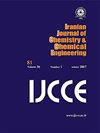花岗岩废弃物中重金属去除的电动力学数值实现
IF 1
4区 工程技术
Q4 CHEMISTRY, MULTIDISCIPLINARY
Iranian Journal of Chemistry & Chemical Engineering-international English Edition
Pub Date : 2021-06-22
DOI:10.30492/IJCCE.2021.130971.4231
引用次数: 0
摘要
本研究的目的是结合电动模型,并估计最大限度地去除污染土壤中重金属的修复时间。传统的电动力学技术大多没有考虑电动力学模型对污染土壤中有机物的去除。我们解决了这一问题,并将电动力学与实验电动力学土壤修复(EKSR)过程结合起来,在MATLAB程序的帮助下提取了HMs去除性能与修复时间之间的数值数据。在恒电压梯度(2V/cm)下,采用螯合化学剂(柠檬酸和乙二胺四乙酸(EDTA))在EKSR工艺中去除花岗岩排土场土壤中的铬(Cr)、钴(Co)、镍(Ni)、铜(Cu)、锌(Zn)和锰(Mn)离子。我们实验研究了在20天的治疗中,螯合剂增强EKSR对HMs的去除性能是未增强时的6 - 7倍。此外,我们使用电动模型估计修复时间约为52至54天,可以完全去除HMs。该研究可为研究人员特别是土壤净化研究人员克服工艺优化中的不确定性,并将工艺扩大到中试工厂和现场水平提供参考。本文章由计算机程序翻译,如有差异,请以英文原文为准。
Numerical Implementation of Electrokinetics for Removal of Heavy Metals from Granite Waste
The goal of the study is to incorporate the electrokinetic models and estimate the remediation time for maximum removal of heavy metals (HMs) from polluted soils. Most of the conventional electrokinetic technologies have not considered the electrokinetic models in the removal of HMs from polluted soils. We addressed this problem and incorporated the electrokinetics and applied for experimental Electrokinetic Soil Remediation (EKSR) process particularly, to extract the numerical data between removal performance of HMs versus remediation time with help of the MATLAB program. In the experimental study, chelating chemical agents (citric acid and ethylenediaminetetraacetic acid (EDTA)) were used in EKSR process under constant voltage gradient (2V/cm) for the removal of Chromium (Cr), Cobalt (Co), Nickel (Ni), Copper (Cu), Zinc (Zn) and Manganese (Mn) ions from granite dump soil. We experimentally investigated that the removal performance of HMs in chelating agents enhanced EKSR were about 6 to7 times more than when unenhanced in 20 days of treatment. Furthermore, we estimated the remediation time about 52 to 54 days for complete removal of HMs using electrokinetic models. The study may be useful for the researcher’s particularly, in the soil decontamination studies to overcome the uncertainty in the process optimization and scale-up the process to the pilot plant and field level.
求助全文
通过发布文献求助,成功后即可免费获取论文全文。
去求助
来源期刊

Iranian Journal of Chemistry & Chemical Engineering-international English Edition
CHEMISTRY, MULTIDISCIPLINARY-ENGINEERING, CHEMICAL
CiteScore
2.80
自引率
22.20%
发文量
0
审稿时长
6-12 weeks
期刊介绍:
The aim of the Iranian Journal of Chemistry and Chemical Engineering is to foster the growth of educational, scientific and Industrial Research activities among chemists and chemical engineers and to provide a medium for mutual communication and relations between Iranian academia and the industry on the one hand, and the world the scientific community on the other.
 求助内容:
求助内容: 应助结果提醒方式:
应助结果提醒方式:


